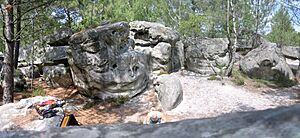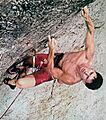History of rock climbing facts for kids

Rock climbing is an exciting sport where people climb up natural rock formations or artificial walls. It's all about using your strength, balance, and smart thinking to get to the top. The history of rock climbing goes back to the late 1800s in Europe.
There are three main types of rock climbing:
- Bouldering: This is climbing on smaller rocks or walls, usually not very high. If you fall, you land on soft mats.
- Single-pitch climbing: This involves climbing routes that are usually less than 100 feet tall. You use ropes and safety gear.
- Big wall climbing: This is climbing very tall rock faces, sometimes thousands of feet high. It can take several days and often involves sleeping on the wall.
Over the years, climbers have found new ways to climb harder routes and explore amazing places. This article will take you through the exciting journey of how rock climbing became the sport it is today.
Contents
- How Rock Climbing Began
- Early Days: The 19th Century
- New Ideas and Gear: The Early 1900s
- Pushing Limits: The 1920s and 1930s
- Post-War Progress: The 1940s and 1950s
- The Golden Age of Free Climbing: The 1960s and 1970s
- The Rise of Sport Climbing and New Heights: The 1980s and 1990s
- New Millennium, New Records: The 2000s and 2010s
- Recent Achievements: The 2020s
- Images for kids
- See also
How Rock Climbing Began
People have been climbing rocks for a long time, sometimes to reach places or hunt birds. For example, in 1492, a Frenchman named Antoine de Ville climbed a 300-meter rock tower called Mont Aiguille. In Scotland, people climbed cliffs in the 1600s to collect birds using ropes.
The "modern era" of mountaineering began in 1786 with the first climb of Mont Blanc. But it took another 100 years for rock climbing to become a sport on its own. This happened in the late 1800s in four main places in Europe:
- England: In the Lake District and Peak District, climbers started tackling short rock routes just for fun. In 1886, Walter Parry Haskett Smith made a famous climb of Napes Needle. This is often seen as the start of rock climbing as a sport in the UK.
- Germany: In Saxon Switzerland, gymnasts began climbing rocks in 1864 using ladders. Later, climbers like O. E. Ufer and H. Frick focused on climbing without aid, which is called "free climbing."
- Italy: In the Dolomites, a 17-year-old named Georg Winkler climbed the Vajolet Towers in 1887. This helped start the trend of climbing huge rock faces, known as big wall climbing.
- France: In the forest of Fontainebleau, climbers started practicing on smaller boulders around 1897. This helped them get better at climbing without ropes, which we now call bouldering.
Early Days: The 19th Century
In the 1800s, climbing was still developing. Here are some key moments:
- 1848: A chimney sweep named Sebastian Abratzky climbed into Königstein Fortress in Germany to avoid paying the entrance fee! This climb, called Abratzkykamin, is now a famous climbing route.
- 1874: Otto Ewald Ufer and H. Frick made the first "free ascent" (no aid) of a rock called Mönch in Germany.
- 1875: George G. Anderson climbed Half Dome in Yosemite, USA, using drilled eye bolts and ropes.
- 1876: Jean Charlet-Straton invented the basic body rappel in the French Alps. This is a way to slide down a rope safely.
- 1881: The Aiguille du Grépon in France was first climbed. It had a difficult section called "Mummery Crack," which was very hard for its time.
- 1887: Georg Winkler climbed the Vajolet Towers in Italy, starting the era of big wall climbing in the Dolomites. He even used special hemp-soled sailor's boots!
- 1892: Steel carabiners appeared in Germany. These metal clips made it easier and safer to connect ropes and gear.
- 1893: Lily Bristow became the first woman to climb the difficult Aiguille du Grepon.
New Ideas and Gear: The Early 1900s
The early 1900s saw new climbing styles and equipment.
- 1900: Oscar Eckenstein showed how to use "balance climbing" on boulders in Wales. This style focuses on smooth, controlled movements.
- 1906: Oliver Perry-Smith and his team climbed Perrykante in Germany, which was the world's first route rated 5b. This was a big step in climbing difficulty.
- 1909: Special felt-soled climbing shoes were introduced, helping climbers grip the rock better.
- 1910: A new design for pitons (metal spikes hammered into cracks for safety) was created by Hans Fiechtl. This design is still used today.
- 1910: Südriss in Germany became the hardest short climb for a decade, rated 6a/a+.
- 1911: Paul Preuss made a famous "free solo" climb (climbing alone without ropes or safety gear) of the East Face of Campanile Basso in Italy.
- 1911: Paul Preuss also started a big discussion about "free climbing" versus "aid climbing" (using gear to help you move up). He believed climbers should only use natural holds on the rock.
- 1913: Hans Dülfer invented the "dülfersitz" rappel, a safer way to slide down ropes. He also created a 5-step grading system for climbs.
- 1918: Westkante in Germany became the world's first route rated 6a+.
Pushing Limits: The 1920s and 1930s
Climbers continued to push the boundaries of what was possible.
- 1921: Kuniskante in Germany became the world's first route rated 6a+/b.
- 1922: Rostkante in Germany became the world's first route rated 6b.
- 1923: Willo Welzenbach created the Roman Numeral European rating system (UIAA grading), which is still used today.
- 1925: NW Face of Monte Civetta in Italy became the world's hardest big wall climb.
- 1927: Laurent Grivel designed and sold the first rock drill and climbing expansion bolt.
- 1927: Fred Pigott started using natural stones and later machine nuts for protection. This led to the invention of the modern climbing nut, which climbers place in cracks for safety.
- 1929: Miriam O'Brien Underhill and Alice Damesme made the first "manless" (all-female) climb of the Aiguille du Grépon.
- 1931: Emilio Comici invented many tools for big wall climbing, like aid ladders and hanging bivouacs (tents for sleeping on the wall). He used them on his huge climb of the Northwest Face of the Civetta.
- 1934: Pierre Allain became a big supporter of bouldering in Fontainebleau. He also created one of the first special climbing shoes by adding rubber to tennis shoes in 1935.
- 1935: Riccardo Cassin and his partner climbed the 700-meter North Face of Cima Ovest in Italy, a very challenging big wall climb.
- 1936: Batista Vinatzer and Ettore Castiglioni made the hardest long, totally free climb in the world on the Marmolada in Italy.
- 1937: Vitale Bramani developed and sold the first rubber-soled boots for climbing, known as "Vibram soles." These soles are still famous today.
- 1938: Riccardo Cassin and his team climbed the amazing Walker Spur on the Grandes Jorasses in France.
Post-War Progress: The 1940s and 1950s
After World War II, new materials and ideas changed climbing.
- 1940s: Inexpensive army-surplus pitons, carabiners, and new nylon ropes became available. Nylon ropes made falling much safer.
- 1946: René Ferlet solved Marie-Rose in Fontainebleau, which was one of the first boulder problems rated 6A.
- 1947: Lightweight aluminum carabiners were introduced, making climbers' gear much lighter.
- 1949: Peter Harding led Demon Rib in the UK, one of the world's first routes rated 6c.
- 1951: Joe Brown climbed Right Eliminate in the UK, a very hard route for its time, wearing tennis shoes!
- 1952: The Yosemite Decimal System (YDS) was created in the USA to grade climbs from 5.0 to 5.9. This system is still widely used.
- 1952: Cesare Maestri made a daring free solo of the 44-pitch Solleder Route in the Dolomites.
- 1952: Joe Brown used pebbles for protection on Cenotaph Corner in Wales, a very bold traditional climb.
- 1953: Edelrid invented the "kernmantle rope" with a protective outer layer, making nylon ropes even safer and more durable.
- 1955: Walter Bonatti made one of the greatest big wall climbs in history, a solo first ascent of a new route on the Dru over six days.
- 1957: Royal Robbins and his team climbed the NW Face of Half Dome in Yosemite. This was the start of modern big wall climbing in the US.
- 1958: John Gill solved Gill Right Problem in Wyoming, the first-ever boulder problem rated V8. He also introduced chalk to climbing, which helps climbers grip better.
- 1958: Warren Harding and his team made the first climb of Nose on El Capitan in Yosemite. It took them 45 days!
- 1959: Royal Robbins and Tom Frost made the hardest big wall free climb in the US on Steck-Salathe route on Sentinel Rock.
- 1959: John Gill solved Red Cross Overhang, the first-ever boulder problem rated V9.
The Golden Age of Free Climbing: The 1960s and 1970s
These decades saw a huge shift towards "free climbing" (climbing using only natural rock features, not pulling on gear).
- 1961: Royal Robbins and his team led the Salathe Wall on El Capitan, a huge achievement in big wall climbing.
- 1961: John Gill made the first free solo of the Thimble in South Dakota, which is now considered the first-ever roped climb rated 7a+.
- 1964: Dan Robinson built the first climbing wall at Leeds University in the UK. This allowed climbers to train indoors.
- 1965: Königshangel in Germany became the first route rated 6c in Germany and one of the hardest in the world.
- 1967: Greg Lowe led Macabre Roof in Utah, the first-ever roped climb rated 7a+.
- 1968: Reinhold Messner climbed Central Pillar in Italy, which is now considered the first-ever climb rated 7a in the Alps.
- 1970: Bernd Arnold led Schwager Nordwand in Germany, one of the world's first routes rated 7a.
- 1971: Yvon Chouinard and Tom Frost promoted "clean climbing" (using gear that doesn't damage the rock, like nuts instead of pitons).
- 1973: John Long led Paisano Overhang in California, considered the first-ever climb rated 7b+.
- 1973: Beverly Johnson and Sibylle Hechtel became the first all-female team to climb El Capitan.
- 1975: Jim Holloway solved Trice in Colorado, considered the first-ever boulder problem rated 8A+.
- 1975: Kurt Albert started painting "Rotpunkt" (redpoint) marks on climbs he had "freed" (climbed without aid). This idea became very important in free climbing.
- 1975: Ron Kauk, John Bachar, and John Long made the first free ascent of Astroman in Yosemite, a very challenging multi-pitch route.
- 1976: Art Higbee and Jim Erickson free climbed the NW Face of Half Dome in Yosemite, rated 5.12d.
- 1977: Ray Jardine led The Phoenix in Yosemite, the first-ever climb rated 7c+. He also invented and sold "cams" (also called "friends"), which made traditional crack climbing much safer.
- 1977: Barbara Devine led Kansas City in the USA, the first-ever female climb rated 7b.
- 1978: Ron Kauk solved Midnight Lightning in Yosemite, one of the first boulder problems rated 7B+.
- 1979: Spanish company Boreal created "sticky rubber" climbing shoes called Firé. These shoes greatly improved climbers' grip on the rock.
The Rise of Sport Climbing and New Heights: The 1980s and 1990s
The 1980s saw the birth of "sport climbing," which uses pre-drilled bolts for safety, leading to much harder climbs.
- 1980: Patrick Edlinger made the first "onsight" (climbing a route perfectly on the first try without any prior knowledge) of La Polka des Ringards in France, rated 7c.
- 1982: John Bachar made the first free solo of Baby Apes in Joshua Tree, rated 7b.
- 1983: Jerry Moffatt made the first "redpoint" (successfully climbing a route after practicing it) of The Face in Germany, the first-ever climb rated 8a+.
- 1984: Wolfgang Güllich redpointed Kanal im Rücken in Germany, the first-ever climb rated 8b.
- 1984: Lynn Hill led Vandals in the USA, the first-ever female climb rated 7c+.
- 1985: Spanish company Boreal created the Boreal Ninja climbing shoe, which became the model for future high-performance shoes.
- 1985: Catherine Destivelle redpointed Fleur de Rocaille in France, one of the first female climbs rated 7c+/8a.
- 1985: Wolfgang Güllich redpointed Punks in the Gym in Australia, the first-ever climb rated 8b+.
- 1985: The first international climbing competition was held in Italy, won by Stefan Glowacz and Catherine Destivelle.
- 1986: Johnny Dawes led some of the hardest traditional climbs in the UK, like Gaia and The Indian Face.
- 1986: Luisa Iovane redpointed Comeback in Italy, the first-ever female climb rated 8a.
- 1986: Jean-Baptiste Tribout redpointed To Bolt or Not to Be in Oregon, the first-ever US climb rated 8b+. This helped establish sport climbing in the US.
- 1987: Wolfgang Güllich redpointed Wallstreet in Germany, the first-ever climb rated 8c.
- 1988: Wolfgang Güllich invented the campus board, a training tool that helped climbers get much stronger.
- 1988: Catherine Destivelle redpointed Chouca in France, the first-ever female climb rated 8a+.
- 1988: Todd Skinner and Paul Piana made the first free ascent of the Salathe Wall on El Capitan, rated 5.13b. This was a huge step for free climbing on El Capitan.
- 1990: Ben Moon redpointed Hubble in England, which might have been the first-ever climb rated 9a.
- 1990: Lynn Hill redpointed Masse Critique in France, the first-ever female climb rated 8b+.
- 1991: Catherine Destivelle made a solo first ascent of Voie Destivelle on the Petit Dru, one of the hardest female first ascents of an Alpine big wall.
- 1991: Wolfgang Güllich redpointed Action Directe in Germany, which is widely considered the first-ever climb rated 9a.
- 1992: Lynn Hill onsighted Simon in Germany, the first-ever female onsight of an 8a route.
- 1992: Fred Nicole solved La Danse des Balrogs in Switzerland, the first-ever boulder problem rated 8B.
- 1993: Lynn Hill made the first free ascent of the 3,000-foot Nose on El Capitan, rated 5.14a/b. This was a massive achievement and she famously said: "It goes, boys."
- 1993: Alain Robert free soloed Compilation in France, the first-ever free solo of an 8b.
- 1994: Stefan Glowacz, Thomas Huber, and Beat Kammerlander each led incredibly hard big wall climbs in the Alps, known as the "Alpine Trilogy," all rated 8b+.
- 1995: Alexander Huber became the first person to free climb all pitches of the Salathe Wall on El Capitan in a single push.
- 1996: Fred Nicole solved Radja in Switzerland, the first-ever boulder problem rated 8B+.
- 1996: Alexander Huber redpointed Open Air in Austria, potentially the first-ever climb rated 9a+.
- 1998: Josune Bereziartu redpointed Honky Tonky in Spain, the first-ever female climb rated 8c.
- 1998: Catherine Miquel solved Duel in Fontainebleau, the first-ever female boulder problem rated 8A.
- 1999: Catherine Destivelle free soloed the Brandler-Hasse Route on the north face of Cima Grande di Lavaredo, the first-ever female free solo of a big wall.
- 1999: The first annual UIAA Bouldering World Cup was held.
New Millennium, New Records: The 2000s and 2010s
The 21st century has seen climbers push grades even higher and climbing become an Olympic sport.
- 2000: Josune Bereziartu redpointed Honky Tonk Mix in Spain, the first-ever female climb rated 8c+.
- 2001: Chris Sharma redpointed Realization/Biographie in France, widely considered the first-ever climb rated 9a+.
- 2001: Alexander Huber redpointed Bellavista in the Dolomites, the first-ever big wall bolted climb rated 8c.
- 2002: Alexander Huber free soloed Hasse-Brandler in the Dolomites, the first-ever big wall solo rated 5.12a.
- 2002: Fred Nicole solved Monkey Wedding and Black Eagle SDS in South Africa, the first-ever boulder problems rated 8C.
- 2002: Josune Bereziartu redpointed Bain de Sang in Switzerland, the first-ever female climb rated 9a.
- 2004: Yuji Hirayama onsighted White Zombie in Spain, the first-ever onsight of a 5.14b route.
- 2004: Tommy Caldwell made the first free ascent of Dihedral Wall on El Capitan, rated 5.14a.
- 2005: Josune Bereziartu redpointed Bimbaluna in Switzerland, the first-ever female climb rated 9a/9a+.
- 2005: Steph Davis became the first woman to free climb the Salathe Wall on El Capitan, rated 5.13b.
- 2006: Dave MacLeod led Rhapsody in the UK, the first-ever traditional climbing route rated E11 7a (5.14c).
- 2006: Josune Bereziartu onsighted Hydrofobia in Spain, the first-ever female onsight of an 8b+ route.
- 2007: The International Federation of Sport Climbing (IFSC) was formed, with the goal of making competition climbing an Olympic sport.
- 2007: Chris Sharma made the first deep water solo of Es Pontàs in Spain, rated 9a+. This is climbing without ropes over water.
- 2008: Chris Sharma redpointed Jumbo Love in California, the first-ever climb rated 9b.
- 2008: Christian Core solved Gioia in Italy, the first-ever boulder problem rated 8C+.
- 2008: Beth Rodden led the first free ascent of Meltdown in Yosemite, the first-ever female traditional climb rated 5.14c, matching the hardest male traditional climb.
- 2012: Alex Honnold became the first to solo (with some aid) the "Yosemite Triple Crown" (three huge walls) in less than 19 hours.
- 2012: Adam Ondra redpointed Change in Norway, the first-ever climb rated 9b+.
- 2013: Adam Ondra redpointed La Dura Dura in Spain, the first confirmed 9b+ climb.
- 2013: Alexander Megos onsighted Estado Critico in Spain, the first-ever onsight of a 9a route.
- 2014: Alex Honnold free soloed the 1,500-foot El Sendero Luminoso in Mexico, a big wall free solo rated 5.12d.
- 2015: Tommy Caldwell and Kevin Jorgeson made the first free ascent of Dawn Wall on El Capitan, rated 5.14d. This was one of the hardest big wall climbs ever.
- 2016: Ashima Shiraishi solved Horizon in Japan, the first-ever female boulder problem rated 8C.
- 2016: The International Olympic Committee (IOC) announced that sport climbing would be a medal sport in the 2020 Summer Olympics.
- 2016: Nalle Hukkataival solved Burden of Dreams in Finland, the first-ever boulder problem rated 9A.
- 2017: Margo Hayes redpointed La Rambla in Spain, the first-ever female climb rated 9a+.
- 2017: Alex Honnold free soloed the 3,000-foot El Capitan via Freerider, rated 5.13a. This incredible feat was featured in the Oscar-winning film Free Solo.
- 2017: Adam Ondra redpointed Silence in Norway, the first-ever proposed 9c climb.
- 2017: Angela Eiter redpointed La Planta de Shiva in Spain, the first-ever female climb rated 9b.
- 2019: Jacopo Larcher led Tribe in Italy, the first-ever traditional climbing route rated 5.14d.
- 2019: Janja Garnbret became the first competition climber to win every IFSC world cup event in a season.
Recent Achievements: The 2020s
- 2020: Angela Eiter led the first free ascent of Madame Ching in Austria, the first-ever female first ascent of a 9b route.
- 2021: Alfredo Webber, at 52, free soloed Panem et Circenses in Italy, the first-ever free solo of an 8c.
- 2021: Alberto Ginés López and Janja Garnbret won the first-ever Olympic climbing gold medals at the 2020 Tokyo Olympics.
- 2021: Janja Garnbret became the most successful competition climber in history with 31 IFSC World Cup golds.
- 2021: Janja Garnbret onsighted Fish Eye and American Hustle in Spain, the first-ever female onsight of an 8c route.
- 2022: Sébastien Bouin redpointed DNA in France, the second-ever proposed 9c climb.
- 2023: Katie Lamb solved Box Therapy in the Rocky Mountain National Park, the first-ever female boulder problem rated 8c+.
Images for kids
-
Riccardo Cassin also set new "hardest-ever" routes in the Alps in the 1930s.
-
Walter Bonatti's climb of the Bonatti Pillar on the Dru made him a big wall climbing legend.
-
Royal Robbins led Yosemite's big wall "Golden Age" from the late 1950s to the early 1970s.
-
Chris Sharma was a dominant male climber in the 2000s.
-
Adam Ondra became the "world's strongest climber" in the 2010s.
-
Alex Honnold made iconic free solo climbs in Yosemite.
-
Tommy Caldwell made iconic big wall climbs in Yosemite.
See also
- History of Aid climbing
- History of Big Wall climbing
- History of Deep-water soloing
- History of Ice climbing
- History of Mixed climbing
- History of Sport climbing
- List of first ascents of mountain summits
- List of grade milestones in rock climbing






















